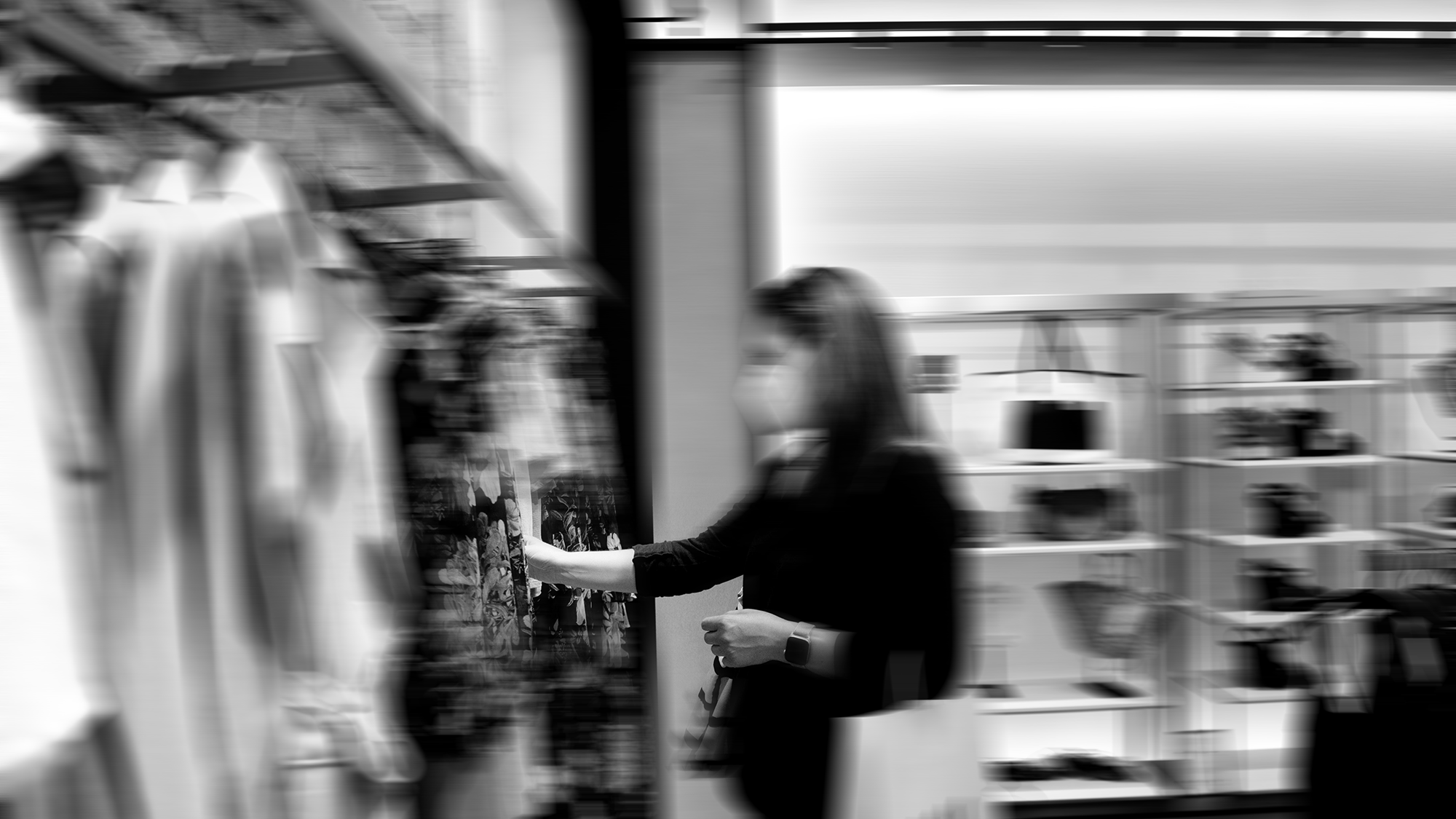Treat the problem, not the symptom

As local store owners report a spike in shoplifting, experts recommend they talk with the people their policies most affect
The Retail Council of Canada estimates the country’s businesses lose $5 billion annually to shoplifting, with its members reporting an increase in violent thefts since 2019, according to Jim Cormier, the organization’s Atlantic Canadian director. He adds the uptick leaves store owners trying to “prevent the massive amounts of theft: filling a cart up with hundreds of dollars of meats or walking out with a flat-screen television.”
He says recent security increases at local grocery stores (barriers around doors, bringing in off-duty cops to work security) aren’t about an occasional chocolate bar. For stores, it’s “constantly balancing a safe and welcoming environment for customers, with a safe and welcoming environment for staff, and at the same time protecting your product.”
When store workers catch shoplifters, he says police don’t always respond quickly, meaning employees must decide whether to detain someone until they arrive, which can be a dangerous situation.
Cormier says the pandemic has been challenging for the sector, with unusual behaviour from the public, including anti-maskers ranting at hapless workers. On the other hand, a July investigation by the Toronto Star suggests supermarkets are making record profits and hiking food prices faster than necessary during inflation. An April report from the Canadian Centre for Policy Alternatives says, “Food and beverage stores, such as grocery stores, made $3.9 billion more pre-tax profit in 2021 than they did before the pandemic, (achieving) record-high profit margins.”
Few have thought as deeply and long as Susan Ayles about shoplifting’s root causes. She is a program manager at the Elizabeth Fry Society in Dartmouth, and has been working with shoplifters for 30 years. She runs Stop Lifting, a non-judgmental program exploring behaviours and underlying causes of shoplifting, theft, and fraud.
When asked about possible links between shoplifting and poverty, Ayles’s answer is matter-of-fact: “It’s not that poor people are the only ones who shoplift. They are the ones who tend to get caught. It’s who gets policed: poor folks, folks of colour, folks in marginalized communities, addicted folks.”
Ayles works with people who have been caught, charged, and sentenced to a restorative justice program. Some of them steal to alleviate poverty; they take either necessities or things to sell. And she works with people who steal for emotional reasons.

“It’s a coping strategy.”
She says many people try shoplifting as youth, but those who keep doing it usually suffered a significant personal loss within six months of the first time they stole.
There’s a psychological release involved, a serotonin boost: “A little joy bump. If you’ve grown up in a system that tells you that you don’t count, or you’re not good at things. It’s a big ol’ ʻfuck you’ to the system.”
Ayles adds that whatever loss large retailers incur from shoplifting, the penalties for those criminalized are far worse. “I have young folks doing federal sentences,” she says. The approach, Ayles notes, is contrary to practices of the provincial justice department, where the policy is to focus on alternatives to involving people in the criminal-justice system for petty crimes.
“Charging people with shoplifting over and over doesn’t do anything,” she says. “Sending people to jail doesn’t keep them from stealing.”
Like an addiction, shoplifting is hard to break.
But those who have stopped, Ayles says, “figured out it was feeding an emotional need. Our program looks at root causes. All the programs and approaches based on correction didn’t change anything.”
She uses a harm-reduction model that minimizes risk factors, like walking into a store with a big bag or coat. Whatever one’s conscious intentions on entering the store, having the means can act as a trigger. She coaches participants to see the psychological struggle as “you against you” rather than “you against the world.”
Krista Dunn, housing manager at YWCA Halifax, has worked with participants living in poverty and at the margins, and has been supervising staff who do the same for 17 years. She says policing shoplifting takes a heavy toll on people living in poverty, whether they shoplift or not. “They’re followed around, harassed, criminalized,” she says.
She is concerned enhanced security makes things worse for marginalized people, “someone who looks stereotypically homeless, or youth; for them it feels more intense. It further criminalizes being poor.”
Recent media reports on crackdowns focus on off-duty police working security at grocery stores, but often unmentioned is that their use is concentrated in lower-income communities, stores “near public housing,” for example. In her experience as a housing worker, and previously at Phoenix Youth Programs, people mostly shoplift to consume (especially food, liquor, and makeup — usually either necessities or things made necessary by living with addiction, like alcoholism). When she worked with homeless teenage girls, makeup was about presenting oneself with pride when society had rarely given them positive reinforcement.
Dunn questions the logic of increased security, particularly in grocery stores during an ongoing pandemic and rampant inflation. “People are struggling more than they ever have before,” she says. “Food banks are a drop in the bucket. People are limited in how much they can use; you get what you get.”
Criminalizing people makes the problem worse, she says. “Now you have a record; now you can’t get a job.”
Dunn and Ayles note another problem with crackdowns on shoplifting: racially profiling Black people, Indigenous people, and other people of colour. The problem is detailed in the seminal Report on Consumer Racial Profiling in Nova Scotia, which surveyed shoppers across Nova Scotia, mostly in the Halifax area.

In the foreword, Nova Scotia Human Rights Commission CEO David Shannon wrote, “Racialized individuals reported being subjected to various humiliating experiences by staff or security personnel … being wrongfully detained, ignored, searched, followed, refused services, given slow service, targeted for offensive language, removed from a store, and questioned about their ability to afford a product.” This happened at “significantly higher prevalence and frequency rates” for “Aboriginal and African Canadian respondents.”
Ann Divine knows what that’s like. She’s a “proud woman of African descent,” principal author of the study, and CEO of Ashanti, an equity, diversity, and inclusion consultancy. “You prepare, you dress well, you make sure you have money in the bank,” she says.
Because of her personal experiences being racially profiled, she rarely uses her credit card, thus avoiding the assumption she has to borrow money. “When (my family) shops, someone has to stand outside with the bags. I’ve been given strange looks, followed around in stores.”
Divine tells of buying books for her grandchildren when she felt a presence beside her. She went to another section of the store; there it was again. Same person. When it happened a third time, she loudly demanded, “Am I being followed here?”
She is confident enough to call it out, but for many the commission surveyed, it’s a deeply humiliating experience. “What we found was quite alarming,” she says. “Young people were being detained because it was felt certain groups of people steal.”
As a business owner herself (though not in retail), Divine understands management’s desire to prevent losses, which she says ultimately come back to hurt paying customers, many of whom are also suffering in the current economy. “I don’t have a problem with the barriers at the front of stores,” she adds.
Her concern is that most security staff, be they wage earners or off-duty police officers, lack the necessary training. “These individuals have to be trained in areas of unconscious bias and inclusion,” she says. “The store would say the security guard is not my responsibility, but you have hired them to keep an eye on your facility. I would encourage employers to really take note and train individuals appropriately.”
The cost of not doing so could be higher than the cost of shoplifting losses. Divine recalls the case of Andrella David. In 2009, staff at a Tantallon Sobeys accused her of stealing, based on grainy security footage of a Black woman (who was not David) shoplifting.
David took the store to a provincial human rights board, which ordered Sobeys to pay her $21,000 for racial discrimination. When the grocery chain fought the ruling, protestors showed up.
“People did boycott that particular Sobeys,” Divine says. “Our communities have quite a bit of purchasing power.”
Cormier says most retailers are careful about their public image. “Retailers understand if there’s an incident, it’s not usually the security firm’s name in the media,” he says.
Gilbert Paul, a father of six from Eskasoni, now living in Sipekne’katik, tweeted this August about his latest experience being racially profiled: a store employee who didn’t identify himself (but made a radio call for backup) followed him around a Walmart.
It happens often. “I have a big family,” Paul says. “When I go shopping my cart is filled up. I didn’t know it was a crime to fill your cart inside a store.”
Paul describes how he and his friends and family have been harassed — followed, receipts checked, being rushed from the store or kicked out without cause — at several different stores including government-owned liquor stores, even as white customers walk by with loaded carts unnoticed.
Ayles says there is a better way for stores to handle shoplifting. “Restorative approaches are the way to go.” That means working to understand the context of people’s underlying motivations and figuring out how to meet those needs.
The Retail Council has worked with the Nova Scotia Human Rights Commission, which developed a program to educate retail employees. “Most retailers signed on for it,” Cormier says. “They showed us what they had and asked for input from our members … Generally members were quite positive about it. Some felt that their own programs were better. But they liked the idea that they could have two programs from which to choose, and others that didn’t have, any appreciated having one.”
The retail council is also working to arrange meetings with provincial justice ministers. “Basically our goal for all of the meetings across Canada with each provincial justice minister is to … put it higher on their radar that when we’re talking about large theft of items, not the small individual items, we need to get more response from police. And we understand that they’re challenged as well, so we just want to have a sit down and dialogue.”
People like Ayles, Dunn, and Divine would also have a lot to contribute to that discussion. Divine recalls a cooking program of the Clayton Park Sobeys that “opened community space to teach young people how to cook, purchase goods, understand money and how it is spent, that nothing is free and why you have to pay for it, and how to use it so there is no waste.” It showed how a business, one store in a large retail chain, could create relationships with its community.
Divine recommends retailers of all sizes “speak to community leaders. Halifax is growing immensely in terms of diversity of cultures. Businesses need to know their community; I’m sure they could learn a lot.”
In writing this story, Unravel Halifax also reached out to major grocery retailers, who refused to discuss shoplifting, plus the Downtown Halifax Business Commission, which did not respond to an interview request.











